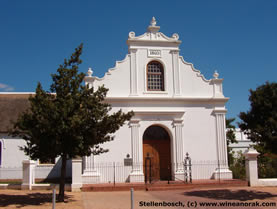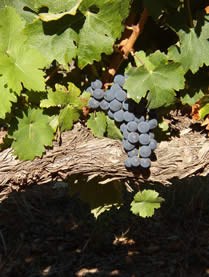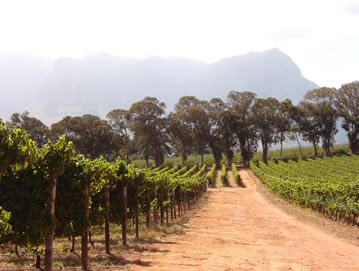
|
Catching
the cape wine bug By
Dominic Hiatt The South African wine industry is buzzing at the
moment. And with an unbeatable combination of fantastic scenery, a
warm climate and affordable, high-quality wine, the western Cape is
currently a happening tourist destination. It seems that just about
everyone’s catching the SA bug. Dominic Hiatt gets Down to Earth in
the winelands of the south western Cape.
The night before, at the delightful Old Mill
restaurant across the road from bloomestate,
Swellendam’s self-entitled ‘luxury retreat’ with its four
seasonal bedrooms and swish breakfasts, I had recklessly
washed down my springbok carpaccio and beef flambé with an entire
bottle of Viljoensdrift River Grandeur 2001 Shiraz. In this fabulous
wine alone, a porty ensemble of pepper, plums, herbs and berries with
a knowing, velvet finish, the South Western Cape, as a wine-producing
region, has clearly arrived. South African wines have certainly made huge strides
in recent years. The social and political developments of the
nineties, along with a surge of private wine initiatives as small
producers have broken away from the big co-operatives, has
significantly improved the quality and variety of wines produced.
“Such is the enthusiasm for wine production,” joked Debbie Viljoen
at Stellenbosch’s Louisvale Wines, “that at
one point in 2002, seven new wineries were opening every week. Some
people were even making wine from their garages.”
One thing that hasn’t changed, of course, is the
favourable Mediterranean climate generated
by the raging African sun, the cold Benguela current streaming up from
Antarctica and the conflict of warm and cold winds whistling in off
the Indian and Atlantic Oceans respectively. The result is warm
summers, rather than hot, and wet, but mild winters relatively
unaffected by frost. Or sometimes, to quote Viljoen, “four seasons
in one week.” The macroclimate is complemented by innumerable
mesoclimates offered by the mountainous terrain, highly varied soils
and equally varied regional rainfalls (as little as 350mm in some
areas, more than twice that in others). All in all, the perfect recipe
for a wine-producing nation. When I hauled myself from the pool, the edges of my
hangover ran off my shoulders and back, cheated by shock. It was still
only nine but the sun was already biting, the white façades of Cape
Dutch homesteads throbbing like heatspots in the distance. But I was
ashamed: I wanted more of the same. Viljoensdrift it was. Deciding to spend another day cruising the winelands
of the South Western Cape, tasting and buying some of the best secrets
the world has to offer, while admiring the incomparable landscape,
wasn’t, admittedly, one of the hardest choices I’ve ever made. It
wouldn’t cost much either. With around fourteen South African rand
to the pound, you can walk away with some seriously good wine for next
to nothing. Take the River Grandeur Shiraz. It set me back around
seven or eight pounds in the Old Mill; it would cost a quarter of that
at Viljoensdrift itself. We got in the car; I handed Tiggy the keys.
The vineyard itself, covering 80 hectares, is located
on the banks of the Breede River itself, the valley’s lifeblood.
Given the quality and range of the wines on offer, it came as a
surprise to learn that Viljoensdrift only started up again in 1998
after a 30-year absence. “Until a few years back, we were part of a
co-operative, growing our grapes, handing them over and then
forgetting about them. But we decided we wanted to produce our own
wines and did just that”, says Fred Viljoen, who runs the vineyard
with his brother, Manie, while also offering trips every Saturday on
the vineyard’s very own riverboat, Uncle Ben. Wine naturally
included. Although Viljoensdrift grows several grape varieties,
including Chardonnay, Chenin Blanc, Cabernet Sauvignon and Pinotage
(South Africa’s own grape, a crossing of Cinsaut and Pinot Noir),
“the preferred grape here”, says Fred, “is Shiraz, which thrives
in a Mediterranean climate similar to that of France.” The stony
limestone soil, he adds, “is full of calcium, which gives complexity
to our reds.” I agree, saying the River Grandeur 2001 Shiraz was
great. The 2000, he hits back, is even better. Annual rainfall in Robertson can be as little as
350mm, although Fred claims the aridity of the land is in fact a big
plus: “We don’t like to give the vines too much water anyway as
this keeps the grapes small and concentrated – we’re able to get
more flavour out of them that way.” Keeping things as natural as
possible is also a major part of the Viljoens’ philosophy, and as a
result they adhere to the guidelines of the environmentally-friendly
Integrated Production of Wine (IPW) scheme: “We don’t like to use
a lot of chemicals, but when we do, we only use chemicals that are
preferred by the South African wine industry”, says Fred. Feeling infinitely better, and with the boot slightly
fuller – there’s a cracking 2001 Semillon too – we bade
Viljoensdrift farewell and drove off into the heat. Cape Town was our
ultimate destination, but we would make two more stops en route, the
viticultural districts of Paarl and Stellenbosch.
Like Viljoensdrift, Villiera is brimming with
confidence, and another wine farm eager to make its mark. With 300
hectares to play with, it certainly has the opportunity to do so,
although to ensure quality, rather than quantity, harvesting is
limited to eight tons per hectare. Size poses other challenges too.
Closer to the Atlantic seaboard, it rains a lot more in Paarl than it
does in Robertson (around 650mm a year on average) so canopy
management is vital, as is sufficient airflow to minimise humidity. Winewise, Villiera produced only Cap Classique
sparkling wine in the early years, although regular visits by Jeff to
Europe and the New World gave him confidence to expand the range of
wines on offer, and develop the techniques used to produce them.
“We’re constantly talking about wine, we keep reading about it,
and we keep travelling to learn more,” says sales representative
Cathy Brewer. For the whites, the focus is on Sauvignon and Chenin,
although Chardonnay and Gewürztraminer are also grown. The former are
blended to produce the wonderful Blue Ridge Blanc, a fruity,
refreshing and gloriously gluggable number that will appeal to all –
from absolute beginner to connoisseur. Selling for about £1.20 a
bottle, this wine symbolises what Villiera is all about. “The
philosophy at Villiera is to produce good wines at a good price,”
adds Cathy. “Blue Ridge Blanc offers incredible value for what you
pay.” It certainly does. But so too does the snazzy-sounding, snazzy-labelled
Down to Earth, a spicy, dark berry blend of Shiraz, Carignan, Gamay
Noir, Merlot and Pinotage. The idea here was to produce a red that
could be enjoyed by all, and which ‘tastes of the earth in which it
grows’. Well, Villiera gets top marks again. Not bad for 90p. Not
bad at all. As we drove back down the long, gravelly
drive, five or ten pounds out of pocket, but five or ten wines in
favour, it all started to get to me. The intense heat, along with a
fair few sips of wine, most recently Down to Earth, had had the quite
opposite effect of sending me upwards, into orbit. One more stop and
then home.
But while it oozes
sleepiness and rustic bliss, in reality Louisvale has been a hotbed of
activity in recent months. In October 2002, the vineyard was purchased
by Michael Johnston, owner of Scotland’s Carnoustie Hotel Golf
Resort & Spa, and Hendrik Kotze, a partner at a Cape
Town law firm. They certainly mean business and
immediately bought up a small neighbouring farm where they
intend to expand the range of homegrown wines,
hitherto limited to Chardonnays of varying degrees of wood. Cabernet
and Merlot are strong front runners to be planted in the decomposed
granite that underpins the soil.
Despite its new acquisition, Louisvale,
with only 28 hectares given to its grapes, remains a boutique,
but one with big, big ambitions. “The UK is a market we
really want to concentrate on,” adds Debbie. Well, with two
wines, the lighter, medium-bodied Chavant Chardonnay, and the Cabernet
LV already on sale at Harrods, they haven’t done badly so far… … And nor, indeed, had we. In one,
heat-hazy day, we had tasted some spectacular wines, bought several
more, seen humbling landscapes and even the odd ostrich. But enough
was enough. Homeward bound. Only forty minutes away from Louisvale
lies the superlative beauty of Cape Town itself. An increasingly
popular holiday jaunt – even long weekend – given the favourable
exchange rate and marginal time difference, ‘Kapstaad’ can satisfy
even the laziest of wine lovers. Indeed, if the
thought of putting too much distance between yourself and the
palm-lined chic of Camps Bay is simply too unbearable, then a trip to
the two bastions of the South African wine industry, Groot and Klein
Constantia on the other side of Table Mountain, via the imposing
Twelve Apostles, is an extremely attractive, if less personal,
alternative. But for wine lovers with a thirst for adventure, there
really is no better place on earth. After all, where else can you mix
your enthusiasm for undiscovered wines with activities as diverse as
whalespotting, game drives, horseriding, watercolour painting, and
diving – with dolphins or the Great White itself?
|
 There
really was no alternative. I pulled on my trunks, pushed through the
French windows of Autumn, flip flopped across the springy grass and
designer gravel and threw myself, all European and ugly, through the
Langeberg Mountains and deep blue skies into cool salvation.
There
really was no alternative. I pulled on my trunks, pushed through the
French windows of Autumn, flip flopped across the springy grass and
designer gravel and threw myself, all European and ugly, through the
Langeberg Mountains and deep blue skies into cool salvation. Margie
Barker, Cape Wine Master at the Cape Wine Academy, toes much the same
line: “The political events of recent years have had an incredible
effect on the South African wine industry, and have opened huge gates
– from the export point of view, but also internally. There has been
a major rethink of how things are done here, the Government has set up
bodies to encourage and help people, and the result is many tremendous
wines.”
Margie
Barker, Cape Wine Master at the Cape Wine Academy, toes much the same
line: “The political events of recent years have had an incredible
effect on the South African wine industry, and have opened huge gates
– from the export point of view, but also internally. There has been
a major rethink of how things are done here, the Government has set up
bodies to encourage and help people, and the result is many tremendous
wines.” A
batch of new French oak barrels has also been rolled in, in an effort
to facilitate “the Burgundian approach to Chardonnay
which the winery is keen to implement”, says spokesperson
Debbie Viljoen, adding that, henceforth, “we will be letting the
wines mature in the bottle for longer prior to release.”
A
batch of new French oak barrels has also been rolled in, in an effort
to facilitate “the Burgundian approach to Chardonnay
which the winery is keen to implement”, says spokesperson
Debbie Viljoen, adding that, henceforth, “we will be letting the
wines mature in the bottle for longer prior to release.”